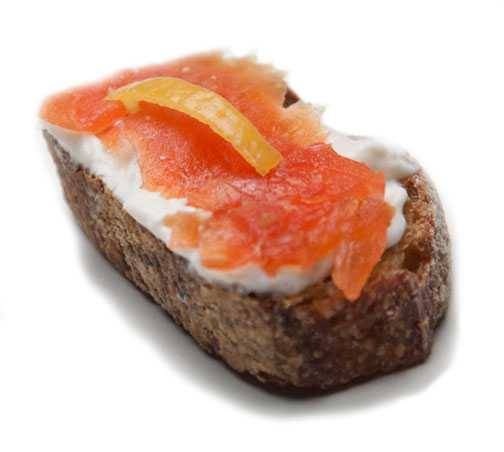Can you say nova lox? Lebanon baloney? Kielbasa? Smoked chub or sable? All fabulous and all cold smoked. Can you also say botulism?
Cold smoking food can be done at home and many people do it expertly, safely, and deliciously. But if you don’t know what you are doing, if you don’t have precision tools and precision control, you can kill. Yes, I know there are websites and books devoted to the subject, but based on my interaction with readers here and in person, I fear many folks who do cold smoking at home don’t fully understand the risks. Grandpa cold smoked his own sausage and lox, they reason, so can they. He lived to a ripe old age, why won’t I?
But today’s food supply is different. Modern factory methods of meat production result in more pathogenic bacteria on meats. To safely cold smoke meats you must have a bulletproof recipe from a pro, not a buddy at work, you must understand some basic scientific principles, you must control the temperature of the smoker and the meat precisely, which means you must have top grade digital thermometers, you must measure the precise amount of salt and/or preservatives with a digital scale, you must cool it properly, and storage temperature after smoking must be precise. If you don’t, you are driving on bald tires, skating on thin ice, playing Russian roulette.
Yes, many people do it. Many people also go 100 mph on the highway. That doesn’t make it safe. I have excellent equipment and extensive knowledge of the subject, yet I never cold smoke. I love my family too much. If I want andouille, I can make a mighty fine one with hot smoke, or I can buy one made in a HACCP certified plant at my grocery store. HACCP means Hazard Analysis and Critical Control Points, and it is a systematic well-established protocol and preventive approach to safe food production from biological, chemical, and physical hazards.
Cold smoking is an old method where the food is not cooked by heat during the smoking process. The air temp around the food is usually below 140°F according to the FDA. It is usually done with one container for generating smoke, another for the food, and a pipe between the two, although there are some clever devices that produce smoke and very little heat that can be placed on grills and even on home made smoke boxes.
Cold smoking cheese, tofu, and nuts at home are relatively low risk. Bacon is not high risk because it is cooked hard before serving, but I still do not recommend cold smoking meats at home, especially for beginners. The risk is too high, especially for children, elderly, pregnant, and immune compromised. The National Center for Home Food Preservation is quite succinct on the subject: “Most food scientists cannot recommend cold-smoking methods because of the inherent risks.”
What is the risk? Among other pathogens, Clostridium botulinum, the botulism bug, the one that makes a neurotoxin that kills people, loves improperly produced sausage and smoked fish. In fact botulism comes from the Latin word botulus which means “sausage”! Listeria monocytogenes is another killer that loves home sausage makers and fish smokers.
The risk of botulism poisoning is low, but it is there. The risk of other pathogens such as listeria is much higher, and they can make you mighty sick. Are you willing to risk killing your family?
The risk from ground meats is higher than any other products, and this means sausages. When animals are slaughtered, contamination from microbes in the gut is usually confined to exposed surfaces and surfaces in contact with contaminated knives, gloves, and tables. This contamination is killed almost instantly when heated in the process of cooking. But if the meat is ground, contamination is distributed evenly through the meat, and the center may not get enough heat to pasteurize it.
Acme Smoked Fish is the largest commercial fish smoker in the nation. I have toured their plant in Pompano Beach, Florida, where they have precise instrumentation and tip top sanitation and a HACCP plan. Yet in 2015 they had to recall some fish. Food safety professor Martin Wiedmann of Cornell University says the problem is that “it’s not hot enough to kill the listeria that comes in the raw fish.”
Listen to this quote from Colorado State University about commercially produced cold smoked salmon: “It is risky for pregnant women, the frail elderly and others with compromised immune systems due to disease or medical therapy. Many countries, including the U.S., recommend these groups avoid cold smoked fish. The shelf life of smoked salmon is very short, one to two weeks in the refrigerator and about one month in the freezer. Storage time is another critical factor in the proliferation of Listeria monocytogenes.”
Heat kills all these bacteria and pathogens. Freezing does not. Alcohol does not. Yes, salt will inhibit their growth, but salt does not kill them all, only those on the surface and just below. Meats left at temperatures between 40°F and 130°F are in “the danger zone”, a range of temps within which microbes reproduce rapidly, sometimes doubling every 20 minutes. If you cook these products to internal temperatures below 130°F you are cooking at a temp that bacteria love. At 130°F the time it takes to pasteurize meat can be hours, and at 165°F the pasteurization time is down to seconds. Because the proper balance of temperature, salt, and preservatives is so delicate, I cannot recommend any cooking below 200°F minimum. And even that is not ideal. The AmazingRibs.com science advisor Prof. Greg Blonder explains: “Even 200°F is tricky because evaporation can cool the meat and keep it in the danger zone for a long time, a phenomenon called ‘the stall’. This is why pros start beef jerky at 165°F in 100% humidity, so there is no evaporative cooling, and the meat is pasteurized. Then they drop the humidity and desiccate the meat.” Commercial jerky makers use preservatives, and still, dried meat recalls are common. For safety and taste, please use my Food Temperature Guide.
If you love cured smoked sausage, I recommend you buy it. Professional sausage makers should have the expertise and all the critical point variables under control. If you love nova lox, buy it. Or click here for my recipe for a divine hot smoked salmon that is perfectly safe. I also have recipes for bacon and pastrami which are cured and hot smoked, so they are safe.
With fish, there is the additional hazard of parasites, like tapeworm. They get into fish flesh, especially if there are mammals in or around their waters whose fecal matter can contaminate their environment. That means people, farm animals, whales, seals, and porpoises. A tapeworm in your intestines can grow to 30′! The Fish and Fishery Products Hazards and Controls Guide says you can kill parasites by freezing to -4°F for seven days, but most home freezers do not go below 10°F and if they are frost-free freezers, they can go up to 32°F in the defrost cycle. Yes, the risk is not much greater than eating sashimi, but in theory, sashimi is the highest grade of fish, and sushi chefs are trained to spot signs of parasites. To get a sense for what you are up against, look at this page on the FDA website.
Finally, if I have not scared you off, if you insist on going down the risky path of cold smoking, read this and buy the book Charcuterie: The Craft of Salting, Smoking, and Curing by Michael Ruhlman. It has superb recipes for making sausages and other cured meats. Follow his instructions carefully.
But don’t come to me for help. I have decided that I will not offer recipes or advice on cold smoking on this website. I want you and your loved ones alive and cooking my safe recipes!



High quality websites are expensive to run. If you help us, we’ll pay you back bigtime with an ad-free experience and a lot of freebies!
Millions come to AmazingRibs.com every month for high quality tested recipes, tips on technique, science, mythbusting, product reviews, and inspiration. But it is expensive to run a website with more than 2,000 pages and we don’t have a big corporate partner to subsidize us.
Our most important source of sustenance is people who join our Pitmaster Club. But please don’t think of it as a donation. Members get MANY great benefits. We block all third-party ads, we give members free ebooks, magazines, interviews, webinars, more recipes, a monthly sweepstakes with prizes worth up to $2,000, discounts on products, and best of all a community of like-minded cooks free of flame wars. Click below to see all the benefits, take a free 30 day trial, and help keep this site alive.
Post comments and questions below
1) Please try the search box at the top of every page before you ask for help.
2) Try to post your question to the appropriate page.
3) Tell us everything we need to know to help such as the type of cooker and thermometer. Dial thermometers are often off by as much as 50°F so if you are not using a good digital thermometer we probably can’t help you with time and temp questions. Please read this article about thermometers.
4) If you are a member of the Pitmaster Club, your comments login is probably different.
5) Posts with links in them may not appear immediately.
Moderators